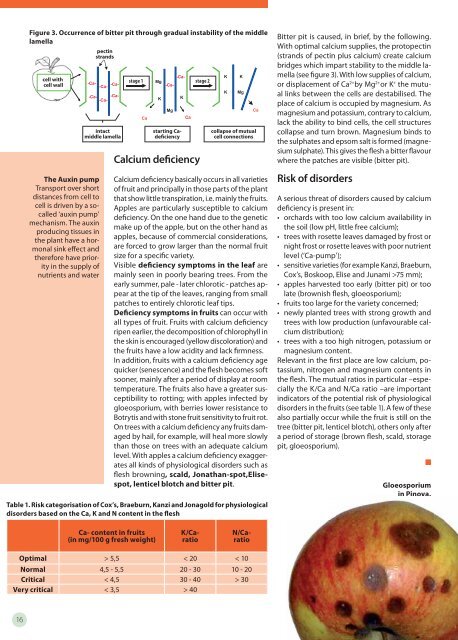In this edition: - The European Fruit Magazine
In this edition: - The European Fruit Magazine
In this edition: - The European Fruit Magazine
Create successful ePaper yourself
Turn your PDF publications into a flip-book with our unique Google optimized e-Paper software.
Calcium defi ciency<br />
Calcium defi ciency basically occurs in all varieties<br />
of fruit and principally in those parts of the plant<br />
that show little transpiration, i.e. mainly the fruits.<br />
Apples are particularly susceptible to calcium<br />
defi ciency. On the one hand due to the genetic<br />
make up of the apple, but on the other hand as<br />
apples, because of commercial considerations,<br />
are forced to grow larger than the normal fruit<br />
size for a specifi c variety.<br />
Visible defi ciency symptoms in the leaf are<br />
mainly seen in poorly bearing trees. From the<br />
early summer, pale - later chlorotic - patches appear<br />
at the tip of the leaves, ranging from small<br />
patches to entirely chlorotic leaf tips.<br />
Defi ciency symptoms in fruits can occur with<br />
all types of fruit. <strong>Fruit</strong>s with calcium defi ciency<br />
ripen earlier, the decomposition of chlorophyll in<br />
the skin is encouraged (yellow discoloration) and<br />
the fruits have a low acidity and lack fi rmness.<br />
<strong>In</strong> addition, fruits with a calcium defi ciency age<br />
quicker (senescence) and the fl esh becomes soft<br />
sooner, mainly after a period of display at room<br />
temperature. <strong>The</strong> fruits also have a greater susceptibility<br />
to rotting; with apples infected by<br />
gloeosporium, with berries lower resistance to<br />
Botrytis and with stone fruit sensitivity to fruit rot.<br />
On trees with a calcium defi ciency any fruits damaged<br />
by hail, for example, will heal more slowly<br />
than those on trees with an adequate calcium<br />
level. With apples a calcium defi ciency exaggerates<br />
all kinds of physiological disorders such as<br />
fl esh browning, scald, Jonathan-spot,Elisespot,<br />
lenticel blotch and bitter pit.<br />
Table 1. Risk categorisation of Cox’s, Braeburn, Kanzi and Jonagold for physiological<br />
disorders based on the Ca, K and N content in the fl esh<br />
Ca- content in fruits<br />
(in mg/100 g fresh weight)<br />
K/Caratio<br />
N/Caratio<br />
Optimal > 5,5 < 20 < 10<br />
Normal 4,5 - 5,5 20 - 30 10 - 20<br />
Critical < 4,5 30 - 40 > 30<br />
Very critical < 3,5 > 40<br />
16<br />
Figure 3. Occurrence of bitter pit through gradual instability of the middle<br />
lamella<br />
cell with<br />
cell wall<br />
<strong>The</strong> Auxin pump<br />
Transport over short<br />
distances from cell to<br />
cell is driven by a socalled<br />
‘auxin pump’<br />
mechanism. <strong>The</strong> auxin<br />
producing tissues in<br />
the plant have a hormonal<br />
sink eff ect and<br />
therefore have priority<br />
in the supply of<br />
nutrients and water<br />
pectin<br />
strands<br />
intact<br />
middle lamella<br />
stage 1 stage 2<br />
starting Cadeficiency<br />
collapse of mutual<br />
cell connections<br />
Bitter pit is caused, in brief, by the following.<br />
With optimal calcium supplies, the protopectin<br />
(strands of pectin plus calcium) create calcium<br />
bridges which impart stability to the middle lamella<br />
(see fi gure 3). With low supplies of calcium,<br />
or displacement of Ca 2+ by Mg 2+ or K + the mutual<br />
links between the cells are destabilised. <strong>The</strong><br />
place of calcium is occupied by magnesium. As<br />
magnesium and potassium, contrary to calcium,<br />
lack the ability to bind cells, the cell structures<br />
collapse and turn brown. Magnesium binds to<br />
the sulphates and epsom salt is formed (magnesium<br />
sulphate). This gives the fl esh a bitter fl avour<br />
where the patches are visible (bitter pit).<br />
Risk of disorders<br />
A serious threat of disorders caused by calcium<br />
defi ciency is present in:<br />
• orchards with too low calcium availability in<br />
the soil (low pH, little free calcium);<br />
• trees with rosette leaves damaged by frost or<br />
night frost or rosette leaves with poor nutrient<br />
level (‘Ca-pump’);<br />
• sensitive varieties (for example Kanzi, Braeburn,<br />
Cox’s, Boskoop, Elise and Junami >75 mm);<br />
• apples harvested too early (bitter pit) or too<br />
late (brownish fl esh, gloeosporium);<br />
• fruits too large for the variety concerned;<br />
• newly planted trees with strong growth and<br />
trees with low production (unfavourable calcium<br />
distribution);<br />
• trees with a too high nitrogen, potassium or<br />
magnesium content.<br />
Relevant in the fi rst place are low calcium, potassium,<br />
nitrogen and magnesium contents in<br />
the fl esh. <strong>The</strong> mutual ratios in particular –especially<br />
the K/Ca and N/Ca ratio –are important<br />
indicators of the potential risk of physiological<br />
disorders in the fruits (see table 1). A few of these<br />
also partially occur while the fruit is still on the<br />
tree (bitter pit, lenticel blotch), others only after<br />
a period of storage (brown fl esh, scald, storage<br />
pit, gloeosporium).<br />
Gloeosporium<br />
in Pinova.



